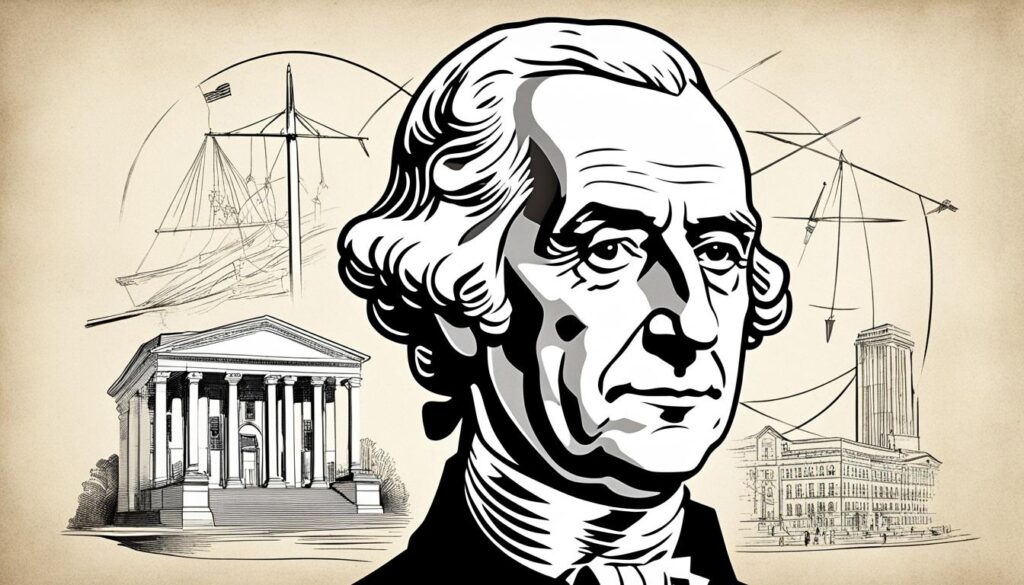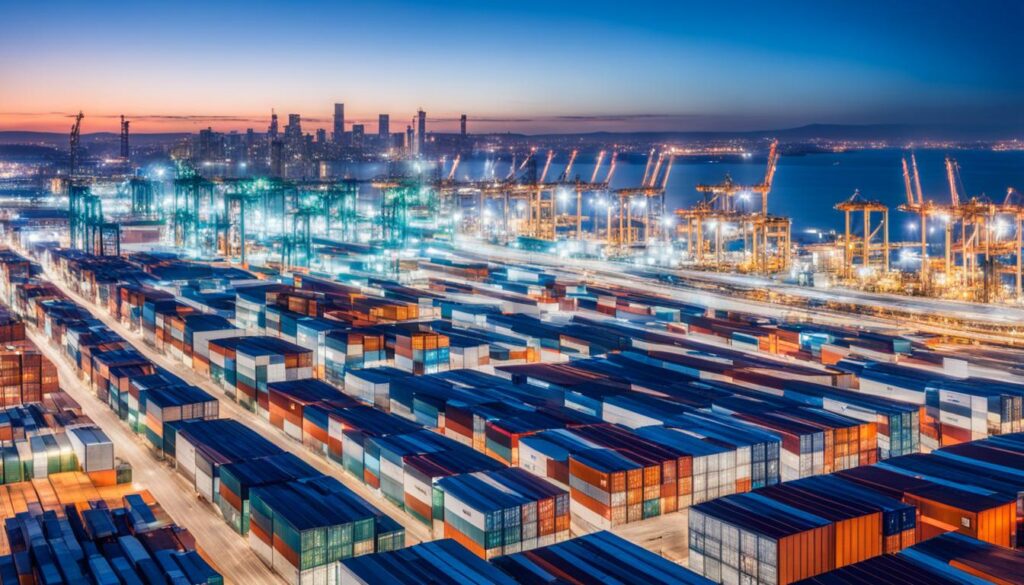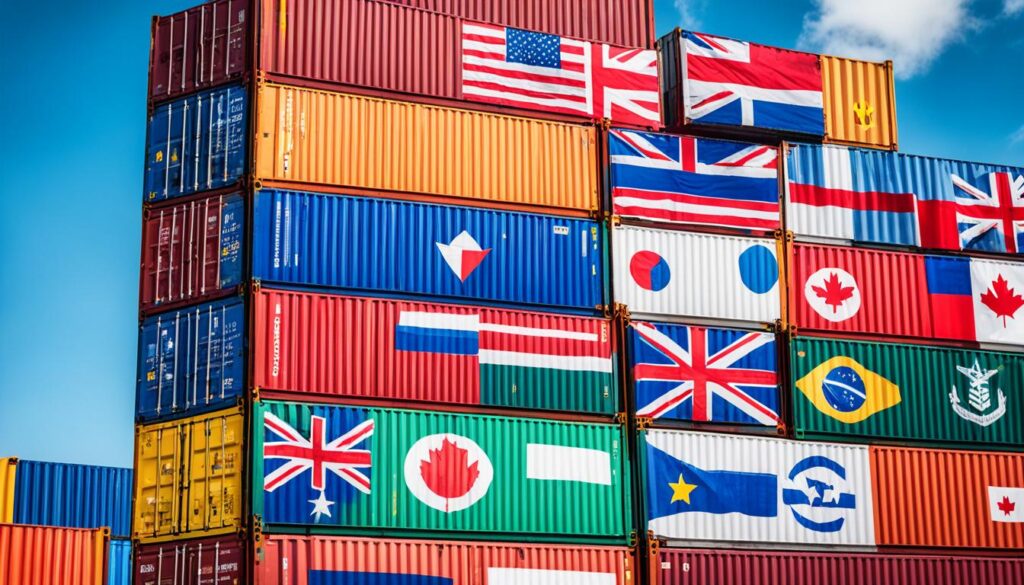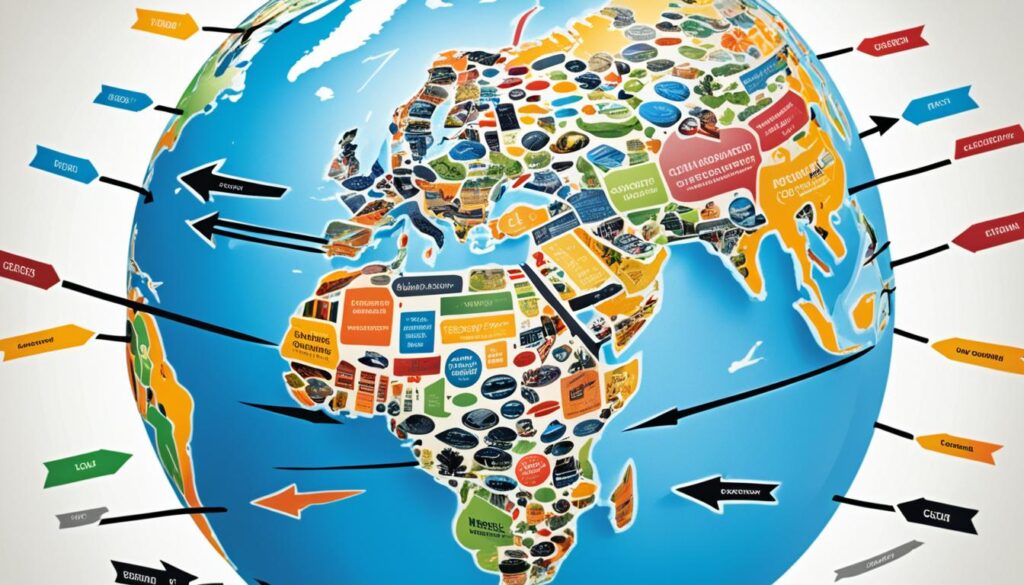Do you believe in the desirability of free trade? Most Western economists do, but what if I told you that trade agreements today go beyond traditional trade restrictions at the border? What if I told you that these agreements cover regulatory standards, investment, intellectual property, labor, and the environment, among other subjects?
In this article, we will dive into the evolution of economic theory and understand how it has shaped modern trade agreements. We will explore the theory of comparative advantage and its implications for international trade deals. Additionally, we will examine the impact of trade agreements on economic development and why it is crucial to reconsider our default attitudes towards these agreements.
Join me on this exploration as we challenge common beliefs and gain a deeper understanding of trade agreements and their role in shaping the global economic landscape.
Key Takeaways:
- Trade agreements have evolved to cover a wide range of policy areas beyond import restrictions.
- The theory of comparative advantage suggests that nations can benefit from trade by specializing in the production of goods where they have a relative advantage.
- The rules and commitments embedded in trade agreements have implications for economic development.
- Reevaluating the practical details and distributional effects of trade agreements is necessary.
- Understanding the politics behind trade agreements is essential for a comprehensive assessment.
The Evolution of Economic Theory
In the seventeenth and eighteenth centuries, the predominant thinking was that a successful nation should have a trade surplus and expand its treasure. This philosophy, known as mercantilism, advocated for government control of economic activity and restrictions on imports. Adam Smith’s book “The Wealth of Nations” challenged this thinking in 1776 by introducing the concept of comparative advantage.
Smith argued that nations can benefit from trade by specializing in the production of goods where they have a relative advantage. Instead of focusing solely on accumulating wealth through exports, Smith believed that a nation’s economic strength lies in its ability to produce goods more efficiently compared to other nations.
“It is the maxim of every prudent master of a family, never to attempt to make at home what it will cost him more to make than to buy… What is prudence in the conduct of every private family can scarce be folly in that of a great kingdom.”
Smith’s concept of comparative advantage revolutionized economic theory and laid the foundation for the principle of free trade. According to comparative advantage, nations should engage in trade based on their respective efficiency levels in production, allowing them to specialize and mutually benefit from exchanging goods and services.
The theory of comparative advantage extended beyond just trade in goods; it also encompasses factors of production such as labor, capital, technology, and natural resources. The focus shifted from mercantilism’s emphasis on accumulation of wealth to Smith’s idea of optimizing efficiency through specialization and trade.

Smith’s Views on Free Trade
Adam Smith viewed free trade as beneficial for both nations involved, as it allows each country to capitalize on its strengths and reap the rewards of specialization. By engaging in trade based on comparative advantage, nations can allocate their resources efficiently, leading to overall economic growth and well-being.
Smith’s ideas laid the groundwork for modern economic theory and greatly impacted the way economists and policymakers think about international trade. They continue to shape discussions surrounding trade agreements and the benefits of globalization.
The Theory of Comparative Advantage
In 1817, David Ricardo expanded upon the concept of comparative advantage, introducing the idea of factors of production. According to this theory, nations will export goods that are produced using factors of production that they possess in abundance, while importing goods that require factors of production in which they are relatively scarce.
The factors of production encompass more than just labor and capital; they also include natural resources and technology. This broad perspective recognizes the diverse elements that contribute to a nation’s comparative advantage in different industries.
By specializing in the production of goods that align with their abundant factors of production, nations can maximize their efficiency and overall economic welfare. This principle of comparative advantage forms the basis for trade decisions and the allocation of resources in the global marketplace.
Ultimately, understanding how labor, capital, and other factors of production influence a country’s ability to compete internationally is crucial in grasping the complexities of trade patterns and economic development.
“The theory of comparative advantage highlights the importance of understanding a nation’s unique mix of labor, capital, and other factors of production in shaping its trade outcomes.”
The Impact of Trade Agreements
Trade agreements today have a far-reaching impact, extending beyond traditional border restrictions. They encompass various policy areas, including regulatory standards, investment, intellectual property, labor, and the environment. These deep trade agreements aim to achieve economic integration between nations by facilitating the free movement of goods, services, capital, people, and ideas.
Deep trade agreements go beyond the simple reduction of tariffs and quotas. They focus on harmonizing regulations and creating a level playing field for businesses operating in multiple countries. By promoting economic integration, these agreements foster closer ties between nations, leading to increased trade and investment flows.
One of the key objectives of deep trade agreements is to establish common standards and rules that promote fair competition and protect the rights and interests of businesses and individuals. These agreements provide a framework for resolving disputes and ensure that participants abide by agreed-upon regulations.
Expanding Policy Areas
The scope of policy areas covered by trade agreements has significantly expanded over time, reflecting the evolving nature of these agreements. Initially, trade agreements primarily focused on reducing barriers to trade in goods. However, they now address a wide range of areas, including services, intellectual property, investment, labor, and the environment.
This expansion reflects a growing recognition that deep economic integration requires addressing various aspects that go beyond tariffs and quotas. It acknowledges the interconnectivity of different policy areas and the need for a comprehensive approach to trade and economic cooperation.
By addressing policy areas such as intellectual property and labor rights, trade agreements aim to establish common standards that promote fair and sustainable trade practices. These agreements provide a framework for cooperation on issues that have a significant impact on global trade and economic development.

The Benefits of Deep Trade Agreements
Deep trade agreements offer several benefits for participating countries. By promoting economic integration, these agreements create opportunities for businesses to expand their markets and access new customers. They also foster innovation and knowledge-sharing by facilitating the free flow of ideas and technology.
Moreover, deep trade agreements contribute to economic growth and development by attracting foreign direct investment, promoting job creation, and improving productivity. They enhance competitiveness and encourage specialization in areas where countries have a comparative advantage, leading to overall welfare gains.
The Challenges of Deep Trade Agreements
While deep trade agreements offer significant benefits, they also pose challenges. Harmonizing regulations across different jurisdictions can be complex and time-consuming. Ensuring adherence to agreed-upon standards requires robust monitoring and dispute settlement mechanisms.
Furthermore, deep trade agreements may have distributional effects, impacting certain industries or groups within society. It is essential to carefully consider the potential consequences and adopt appropriate policies to mitigate any adverse effects.
| Benefits of Deep Trade Agreements | Challenges of Deep Trade Agreements |
|---|---|
| Expanded market access and increased trade | Complexity of harmonizing regulations |
| Promotion of innovation and knowledge-sharing | Monitoring and enforcement of agreed-upon standards |
| Economic growth, job creation, and productivity improvement | Potential distributional effects on certain industries or groups |
Trade Agreements and Economic Development
Deep trade agreements play a crucial role in shaping economic development. The rules and commitments embedded in these agreements have far-reaching implications for how countries transact, invest, work, and ultimately develop. By establishing a framework of regulations and obligations, trade agreements provide the necessary structure to foster economic growth and cooperation on a global scale.
When crafting trade agreements, it is imperative for policymakers to base their decisions on evidence and development priorities rather than international power dynamics or domestic politics. This ensures that the rules and commitments reflect the specific needs and goals of each participating country, promoting a more balanced and equitable economic landscape.
Practical details are vital in ensuring the effective implementation of trade agreements. From tariff reductions and market access provisions to intellectual property rights and dispute settlement mechanisms, the specific provisions within trade agreements determine their impact on various sectors of the economy. Careful consideration of these details is essential for maximizing the benefits and minimizing potential drawbacks.
Moreover, data and analysis on trade agreements provide valuable insights into their content and consequences. By examining the outcomes of past agreements, policymakers can identify successful strategies and areas for improvement. This evidence-based approach allows for informed decision-making and the refinement of future trade agreements to better serve the interests of economic development.
Supporting Economic Growth and Prosperity
Trade agreements have the potential to stimulate economic growth by promoting international trade and investment. By reducing trade barriers and establishing transparent regulations, these agreements facilitate the flow of goods, services, and capital across borders. This increased economic integration opens up new markets for businesses, leading to greater opportunities for expansion and innovation.
Furthermore, trade agreements can contribute to poverty reduction and improved standards of living. By creating a more conducive environment for trade, these agreements promote job creation, foster competition, and attract foreign direct investment. As a result, countries can benefit from increased employment opportunities, higher wages, and improved access to essential goods and services.

However, it is crucial to recognize that the benefits of trade agreements may not be evenly distributed. Some industries or regions may experience temporary disruptions or face challenges in adapting to increased competition. Addressing these distributional issues requires targeted policies and investments to support affected communities and ensure that the gains from trade are shared more inclusively.
Deep trade agreements have the potential to shape economic development, but their success hinges on well-designed rules and commitments that prioritize evidence and development priorities over power dynamics or domestic politics. – [Author Name]
Key Considerations for Successful Trade Agreements
When designing trade agreements for economic development, policymakers should consider several key factors:
- Alignment with development priorities: Trade agreements must align with a country’s unique development priorities, taking into account its comparative advantages, resource endowments, and sustainable development objectives. This ensures that the rules and commitments within the agreement contribute to long-term economic growth and social welfare.
- Inclusivity and cooperation: Trade agreements should promote inclusive economic growth by integrating sectors and stakeholders that have traditionally been marginalized. Involving a wide range of stakeholders, including government agencies, civil society organizations, and local communities, fosters cooperation and ensures that multiple perspectives are considered in the agreement’s design and implementation.
- Capacity building and technical assistance: Adequate support for capacity building and technical assistance is crucial for countries to fully harness the benefits of trade agreements. Assistance in areas such as trade facilitation, customs administration, and compliance with international standards helps countries overcome implementation challenges and maximize the gains from participation in global trade.
By addressing these considerations and prioritizing the long-term sustainable development of participating countries, trade agreements can truly become catalysts for economic growth and prosperity.
Reconsidering Trade Agreements
As the nature of trade agreements continues to evolve, economists must reevaluate their default attitudes towards these agreements. Trade agreements today extend far beyond import restrictions, encompassing a wide range of topics and aiming for deep integration among nations. It is crucial to examine trade agreements from a political economy perspective, considering their potential to empower certain special interests and politically well-connected firms.
The distributional effects of trade agreements also demand careful consideration. While such agreements can promote overall economic growth, they may not benefit all sectors or individuals equally. It is essential to analyze how trade agreements impact various groups within societies and address any potential distributional inequalities.
“Trade agreements may empower certain special interests and politically well-connected firms.”
In addition to distributional effects, economists should also be mindful of rent-seeking behavior within trade agreements. Rent-seeking refers to the pursuit of economic gain through activities that do not create new wealth but rather involve redistributing existing wealth. Trade agreements can inadvertently create opportunities for rent-seeking behavior, which can distort economic efficiency and lead to suboptimal outcomes.

Considering the practical details and potential consequences of trade agreements is crucial for informing policy decisions. By conducting thorough analyses and evaluations of trade agreements, economists can contribute to a more comprehensive understanding of their positive and negative effects on the global economy.
The Distributional Effects of Trade Agreements
An examination of the distributional effects of trade agreements reveals that their impacts can vary across industries and social groups. While some industries may experience increased competitiveness and growth due to trade liberalization, others may face challenges and economic dislocation. It is vital to understand these distributional effects to design appropriate policies and interventions that mitigate potential negative consequences for vulnerable communities.
| Industry | Impact |
|---|---|
| Manufacturing | Increased competition from lower-cost imports may lead to job displacement and downward pressure on wages. |
| Agriculture | Access to new markets can benefit farmers through increased exports, but it may also expose them to international competition, affecting small-scale and subsistence farmers. |
| Services | Trade agreements can create opportunities for service exports, benefiting industries such as tourism, finance, and technology. |
| Workers | Trade agreements can lead to changes in the labor market, affecting wages, job security, and working conditions. |
Understanding the distributional effects of trade agreements is crucial for designing targeted policies that address the specific challenges faced by affected industries and workers. By considering the impacts on different sectors and communities, economists can contribute to a more equitable and inclusive approach to trade policy.
Experts’ Views on Trade Agreements
In a survey conducted by the Booth School of Business at the University of Chicago, leading economists expressed near-unanimous support for both the general concept of free trade and the North American Free Trade Agreement (NAFTA).
This overwhelming endorsement from economists highlights their belief in the overall benefits of free trade and their recognition of trade agreements as a means to counter protectionist interests. It demonstrates the economists’ understanding that promoting international trade can lead to positive economic outcomes for nations involved.
However, recent research has shed light on the nuanced impact of NAFTA on the US economy. While the agreement was intended to generate significant efficiency gains for the country, studies have shown that its net efficiency gains were relatively modest. Furthermore, certain groups and communities experienced negative consequences as a result of the agreement.
Despite these findings, economists continue to emphasize the importance and potential advantages of trade agreements. Their support for NAFTA suggests that, from an economist’s perspective, the overall gains from trade outweigh any negative effects or distributional challenges.
The economists’ viewpoints on trade agreements underscore the role of experts in assessing and advocating for trade policies that prioritize economic prosperity and global cooperation. While it is essential to critically analyze the practical details and distributional consequences of trade agreements, economists’ support for these agreements reflects their understanding of the broader benefits they can bring.
Notable Quotes
“Trade agreements contribute to economic growth and development by promoting free trade and reducing barriers to international commerce. They represent an essential tool for fostering economic cooperation and countering protectionist forces.” – Leading economist, University of Chicago
Expert Perspectives in Numbers
| Economists’ Views on Trade Agreements | Percentage of Economists |
|---|---|
| Support for free trade | 97% |
| Support for NAFTA | 94% |
The Politics of Trade Agreements
When it comes to trade agreements, there are distinct perspectives from a political economy standpoint. One viewpoint posits that import-competing interests play a dominant role in shaping trade policy. These are the industries and sectors that are directly affected by competition from foreign imports. Their concerns revolve around protecting domestic jobs, industries, and market shares against foreign competitors.
On the other hand, there is another perspective that considers trade agreements as primarily serving the interests of politically well-connected firms. These are the special interests that stand to benefit from trade liberalization, such as multinational corporations with global supply chains or industries that rely on access to foreign markets. These politically influential actors often engage in rent-seeking behavior, using their connections to influence trade policy in ways that favor their own interests.
“Trade agreements can produce mutually beneficial trade, but they may also result in welfare-reducing or purely redistributive outcomes.”
The complex politics surrounding trade agreements means that the outcomes can vary widely. While trade agreements have the potential to facilitate economic growth and create new opportunities, they can also lead to detrimental consequences. Some agreements may result in the displacement of workers in import-competing industries, leading to job losses and increased inequality. Moreover, rent-seeking behavior by special interests can distort the intended benefits of trade agreements, favoring certain businesses over others and perpetuating existing power dynamics.
To fully understand the impact of trade agreements, it is essential to delve into the intricate web of political interests and their interactions. This includes examining the influence of import-competing interests, rent-seeking behavior, and special interests, as well as the potential distributional effects of trade agreements.

The Need for Rethinking Trade Agreements
As the landscape of trade agreements continues to evolve, it is crucial for economists to reassess their default attitudes towards these agreements. The traditional approach to evaluating trade agreements based solely on efficiency gains may not fully capture the distributional questions and practical details that can significantly impact different groups.
By reconsidering the practical details, distributional consequences, and political economy factors, economists can adopt a more comprehensive and informed approach to analyzing the benefits and drawbacks of trade agreements. This nuanced understanding will contribute to a more holistic view of how these agreements shape global economic landscapes.
Efficiency gains, while important, should not be the sole focus in evaluating trade agreements. Distributional questions, such as how the benefits and costs are distributed among different groups within society, are equally significant. Practical details, such as the inclusion of labor and environmental standards, regulatory harmonization, and intellectual property protections, also play a crucial role in shaping the outcomes of trade agreements.
By reassessing our perspectives and addressing these distributional questions and practical details, we can ensure that trade agreements benefit all members of society. This requires a multidimensional approach that goes beyond economic theory and incorporates a thorough analysis of the real-world implications and potential trade-offs of these agreements.






